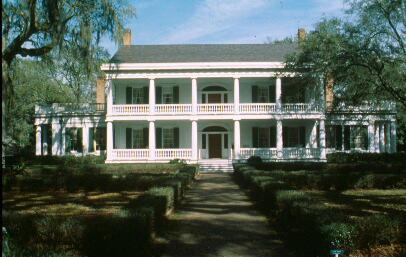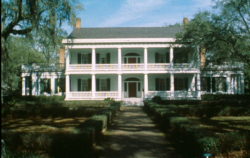Rosedown Plantation State Historic Site
Rosedown Plantation in Louisiana is one of the most intact and well-documented examples of a plantation complex in the South.

Courtesy of Louisiana Department of Culture, Recreation & Tourism
Rosedown Plantation. Louisiana Departrment of Culture, Recreation & Tourism
Tn 1834 Scottish-born cotton planter Daniel Turnbull and his wife, Martha Barrow Turnbull, commissioned Wendell Wright, contractor for the West Feliciana Railroad, to build their St. Francisville house, named Rosedown, in the “most modern style. Constructed of cypress and cedar, some of which was processed at the plantation’s sawmill, the two-story house features a two-story gallery with Doric columns and entablature and a central doorway, surmounted by a fanlight, on each floor. One-story brick side wings, added in 1845 and designed as miniature Greek temples with end porticoes, complete a balanced and well proportioned ensemble. In plan, the house blends the traditional Louisiana rear gallery set between cabinet rooms with an Anglo American central hall containing a wooden spiral staircase. Some of the furniture was purchased in Europe while the Turnbulls were on their honeymoon six years earlier.
Several mid-nineteenth-century dependency buildings survive, among them the kitchen, a pigeonnier, a doctor’s office with a Greek Revival gallery, a two-story barn with a central open passage, a milk shed covered by a pyramidal shake roof and enveloped by galleries to shade the walls of hewn logs, and a square clapboard privy.
Rosedown’s gardens are justly famous. The house is approached by way of a 660-foot-long alley of oaks planted as acorns by Martha Turnbull. She planned and developed the twenty-eight-acre garden, which included peach, fig, apple, and quince orchards; a kitchen garden; a cold pit; a large conservatory; and the pleasure garden. The last included both formal parterres with boxwood hedges and winding pathways among flowering bushes and roses; the azaleas and camellias there, some of which survive in the garden, were among the first to be introduced into the United States. Three wooden latticework gazebos with onion-shaped roofs add focal points. From 1837 until the year before her death in 1896, Martha Turnbull kept a meticulous record of her work on the gardens, which was utilized in a restoration by Houston landscape architect Ralph Ellis Gunn in the 1960s. The garden originally included imported Carrara marble statues, but these were sold by the owner in 2000, along with furniture from the house. Rosedown was purchased by the state of Louisiana that same year under the direction of then Lieutenant Governor Kathleen Babineaux Blanco. State employees replaced the original statues with copies to restore the gardens to their former glory.
The Turnbulls were a family of enormous wealth. In 1850, they owned 347 slaves to work on their land and in the house, and the 1860 census records that they had 444 enslaved workers on three plantations. They spent the summer months in the East and had their portraits painted by Thomas Sully. When in residence at Rosedown, the Turnbulls made it one of the great social centers of the plantationowning families in West Feliciana. After the Civil War and the death of her husband and son, Martha Turnbull managed Rosedown Plantation. The house and gardens are now open for tours. Rosedown’s house appears to have influenced Weyanoke Plantation House near Bains, which began as a log cabin and was remodeled between 1838 and 1856 by John Turnbull Towles, a relative of the Rosedown Turnbulls.
Adapted from Karen Kingsley’s Buildings of Louisiana, part of the Buildings of the United States series commissioned by the Society of Architectural Historians (www.sah.org) and published by Oxford University Press.
